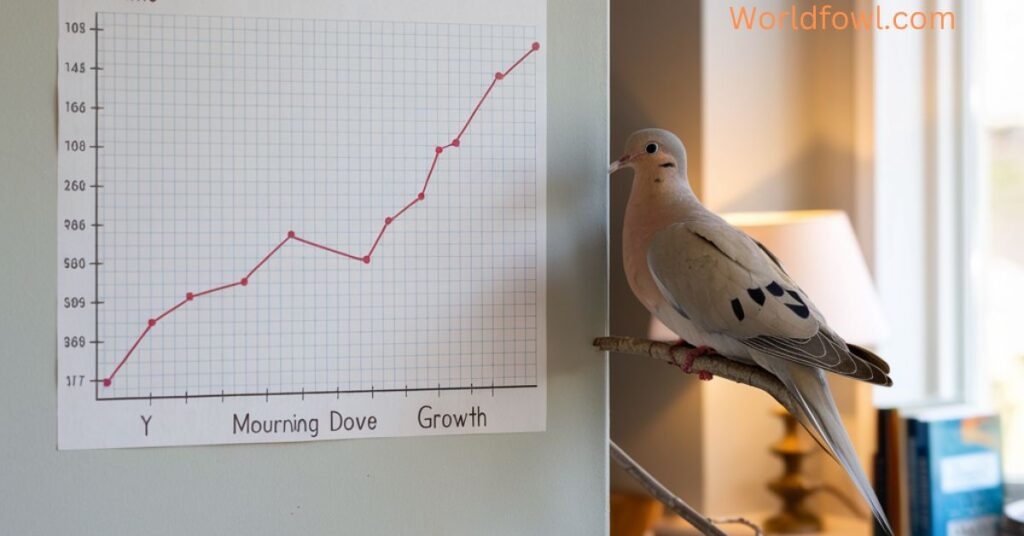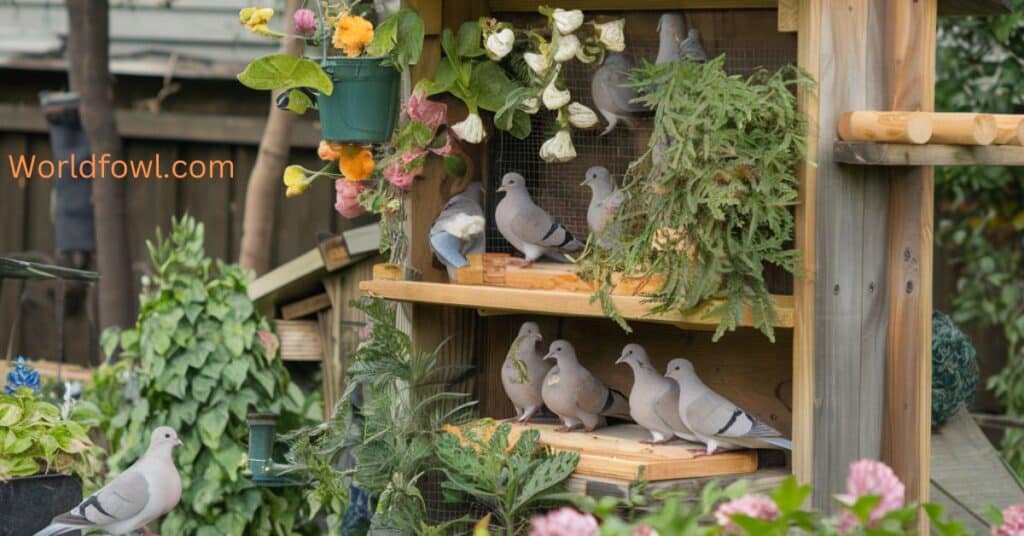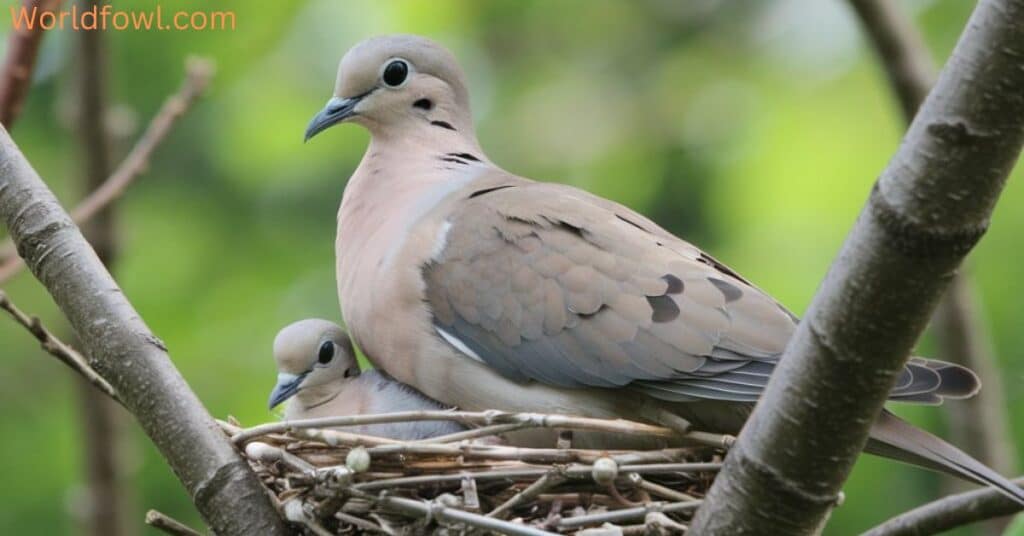Mourning doves, with their gentle coos and graceful flight, have long captivated bird enthusiasts and casual observers alike. These ubiquitous birds, found across North America, offer a fascinating glimpse into the world of avian parenting. In this comprehensive guide, we’ll unravel the mysteries of Mourning Dove nesting, from their unique courtship rituals to the fledging of their young. Whether you’re a seasoned birder or simply curious about the feathered families in your backyard, this journey through the life cycle of Mourning Doves promises to enlighten and inspire.
The Gentle Cooing Neighbors: An Introduction to Mourning Doves

Mourning Doves (Zenaida macroura) are among the most widespread and abundant birds in North America. Their soft, mournful cooing—which gives them their name—is a familiar sound in both urban and rural landscapes. These medium-sized birds, with their sleek bodies and long, tapered tails, are a common sight at bird feeders and on telephone wires across the continent.
Why Understanding Mourning Dove Nesting Matters:
- Ecological Importance: Mourning Doves play a crucial role in seed dispersal and as prey for various predators.
- Urban Wildlife: Their adaptability to human environments makes them excellent subjects for studying urban ecology.
- Conservation: Monitoring nesting habits helps track population health and guides conservation efforts.
As we delve deeper into the nesting habits of Mourning Doves, we’ll discover the intricate ways these birds have adapted to thrive alongside humans while maintaining their wild nature.
The Art of Dove Real Estate: Choosing the Perfect Spot

When it comes to selecting a nest location, Mourning Doves display a remarkable flexibility that has contributed to their success as a species.
Preferred Nesting Locations
Mourning Doves typically seek out the following spots for their nests:
- Trees and Shrubs: Deciduous or evergreen, these provide cover and support.
- Building Ledges: Urban doves often utilize window sills and roof edges.
- Hanging Planters: Particularly popular in suburban areas.
- Abandoned Nests: They may repurpose old nests from other bird species.
Urban vs. Rural Nesting Habits
| Urban Settings | Rural Settings |
| Building ledges | Dense shrubs |
| Hanging planters | Low tree branches |
| Awnings | Fence posts |
| Air conditioning units | Farm equipment |
In cities, Mourning Doves have become adept at using human structures, often nesting on ledges and in planters. Rural doves, on the other hand, tend to stick to more traditional sites like trees and shrubs. However, they’re not above using abandoned farm equipment or fence posts as nesting platforms.
Surprising Nesting Sites You Might’ve Missed
Mourning Doves are known for their sometimes quirky choices in nest location. Here are a few unexpected places where observers have found Mourning Dove nests:
- Inside wreaths on front doors
- Atop patio lights
- In gutters or downspouts
- On active construction equipment
- Within dense vines growing on walls
These unusual choices highlight the adaptability of Mourning Doves and their willingness to nest close to human activity if the spot feels secure.
you may also like : Do Mockingbirds Mate For Life? The Scandalous Lives Of Mockingbirds
Mourning Dove Nest Architecture

The Mourning Dove nest is a testament to minimalism in the bird world. Unlike the elaborate constructions of some species, doves nest with a “less is more” approach. This simplicity, however, belies the effectiveness of their nesting strategy.
Materials Used in Construction
Mourning Doves are not picky about their building materials. They typically use:
- Twigs
- Pine needles
- Grass stems
- Rootlets
- Occasionally, bits of string or debris
The male dove usually gathers the materials, while the female oversees construction. This division of labor ensures efficient nest-building, which can be completed in just a few days.
The Not-So-Intricate Design: Form Follows Function
A Mourning Dove nest is often described as flimsy or haphazard. Here’s why this seemingly slapdash approach works:
- Quick Construction: The simple design allows for rapid building, crucial for a species that may produce several broods per season.
- Adaptability: The loose structure can conform to various surfaces and shapes.
- Camouflage: The sparse nature of the nest helps it blend with surroundings.
- Drainage: Gaps in the structure allow rainwater to pass through, preventing drowning of eggs or chicks.
Despite its apparent flimsiness, the nest is surprisingly resilient. The weight of the incubating parents actually helps to solidify the structure over time.
How to Spot a Mourning Dove nesting (Without Disturbing the Residents)

Identifying a Mourning Dove nest requires a keen eye and respect for the birds’ space. Here are some tips:
- Look for a Shallow Bowl: About 5-6 inches in diameter.
- Watch for Activity: Doves flying to and from a specific spot repeatedly.
- Listen for Soft Cooing: Often heard near the nest site.
- Check Common Areas: Horizontal branches, ledges, or hanging planters.
Remember: It’s crucial to observe from a distance. Disturbing nesting birds is not only stressful for them but can also be illegal in many jurisdictions.
The Circle of Dove Life: Reproductive Timeline
The reproductive cycle of Mourning Doves is a well-orchestrated series of events, timed to maximize the survival of their young. Understanding this timeline provides insight into the dedication these birds show to perpetuating their species.
Courtship Rituals: Love is in the Air
Mourning Dove courtship is a subtle yet beautiful dance that typically begins in early spring. Here’s what to look for:
- The Flight Display: Males perform a graceful, circular flight, rising with noisy wing beats and then gliding down with wings outstretched.
- Cooing Serenade: Males perch and coo to attract females, often puffing out their necks.
- Bowing and Preening: Once a female shows interest, the pair will bow to each other and engage in mutual preening.
- The “Nest Show”: Males will lead females to potential nesting sites, cooing softly to encourage approval.
These rituals not only serve to attract a mate but also strengthen the pair bond, crucial for the cooperative effort of raising young.
you might also like : Do Crows Eat Other Birds? The Disturbing Truth
Egg-Laying Season: When to Expect New Neighbors
Mourning Doves have one of the longest breeding seasons of any bird in North America. In warmer regions, they may nest year-round, while in cooler areas, the season typically runs from March to September.
Key Facts About Mourning Dove Egg-Laying:
- Nesting Season Duration: 7-8 months in most areas
- Number of Broods: 2-5 per season
- Time Between Broods: As little as 30 days
“The prolific nature of Mourning Dove breeding is a key factor in their abundance and adaptability.” – Dr. David Blockstein, ornithologist
Incubation Period: The Waiting Game
Once the eggs are laid, both parents share incubation duties:
- Incubation Length: 14 days on average
- Male Shift: Typically 10 AM to 6 PM
- Female Shift: Evening to morning
This shared responsibility ensures the eggs are constantly kept warm and protected, increasing the chances of successful hatching.
Mourning Dove Families: By the Numbers
The reproductive strategy of Mourning Dove nesting is characterized by multiple broods of small clutches. This approach allows them to balance the risks of predation with the potential for multiple successful nests throughout the season.
Clutch Size: How Many Eggs to Expect
A typical Mourning Dove nest contains:
- Number of Eggs: 2 (rarely 1 or 3)
- Egg Color: Pure white
- Egg Size: Approximately 2.8 cm x 2.1 cm
The consistency in clutch size is remarkable, with two eggs being the norm across nearly all nests. This allows both parents to efficiently incubate and care for the young.
Hatching Success Rates
Mourning Doves have a relatively high hatching success rate compared to many other bird species:
| Factor | Percentage |
| Eggs that hatch | 70-80% |
| Nests producing at least one fledgling | 60% |
| Overall nest success (fledging young) | 50-60% |
These high success rates contribute to the stable populations of Mourning Doves across their range.
Multiple Broods: The Busy Parents of the Bird World
Mourning Doves are known for their ability to produce multiple broods in a single season:
- Average Number of Broods: 2-3 per season
- Maximum Recorded: Up to 6 broods in ideal conditions
- Time Between Broods: As short as 30 days
This rapid turnaround is possible due to several factors:
- Short incubation period
- Quick development of young
- Division of parental care duties
Case Study: A Season of Succession In a study conducted in Southern California, researchers tracked a pair of Mourning Doves through an entire breeding season. The results were impressive:
- March 15: First nest initiated
- April 20: First brood fledged
- April 25: Second nest started
- May 30: Second brood fledged
- June 5: Third nest begun
- July 10: Third brood fledged
- July 15: Fourth nest initiated
- August 20: Fourth brood fledged
This case demonstrates the remarkable reproductive capacity of Mourning Doves when conditions are favorable.
you may also like : Backyard Small Birds In Florida – 10 Wonderful Florida Backyard Birds
From Egg to Sky: The Mourning Dove Growth Chart

The journey from egg to fledgling is a rapid one for baby Mourning Doves. Their quick development is a survival strategy, minimizing the time they’re vulnerable in the nest.
Hatchling Characteristics
When Mourning Dove eggs hatch, the chicks are:
- Size: About 5 cm long
- Weight: Approximately 5-6 grams
- Appearance: Mostly naked with sparse yellow down
- Eyes: Closed
- Dependency: Completely reliant on parents
Nestling Development Milestones
The growth of Mourning Dove babies is remarkably fast:
| Age (Days) | Development Milestone |
| 0-2 | Eyes closed, fed crop milk |
| 3-4 | Eyes begin to open |
| 5-6 | Pin feathers emerge |
| 7-8 | Feathers start to unfurl |
| 9-11 | Fully feathered, begin to move around nest |
| 12-14 | Ready for first flight |
First Flight: When Do Fledglings Leave the Nest?
Mourning Dove fledglings typically leave the nest at 12-14 days old. However, they don’t stray far:
- First Flights: Short and clumsy, often to nearby branches
- Parental Care: Continues for 1-2 weeks post-fledging
- Independence: Gradually achieved over several weeks
“The rapid development of Mourning Dove chicks is a testament to the effectiveness of their parental care and feeding strategies.” – Dr. Eleanor Hespenheide, Wildlife Biologist
Roles and Responsibilities
Mourning Dove nesting involves a cooperative effort between both parents, with clearly defined roles that ensure the best chances of survival for their young.
Male vs. Female Contributions
Both parents are heavily involved in childcare, but their roles differ slightly:
Male Responsibilities:
- Gathering nesting materials
- Incubating eggs (primarily during the day)
- Defending the nest
- Feeding young
Female Responsibilities:
- Constructing the nest
- Incubating eggs (primarily at night)
- Brooding young chicks
- Feeding young
This division of labor allows for constant care of the eggs and chicks while also enabling the parents to forage and maintain their own health.
Feeding Habits: Crop Milk and Beyond
Mourning Doves have a unique way of feeding their young:
- Crop Milk Stage (0-5 days):
- Both parents produce a nutrient-rich secretion called crop milk
- High in protein and fat, low in carbohydrates
- Sloughs off the lining of the crop (part of the esophagus)
- Transition Stage (5-10 days):
- Gradual introduction of regurgitated seeds mixed with crop milk
- Helps young transition to adult diet
- Seed Diet (10+ days):
- Primarily regurgitated seeds and occasional insects
- Prepares fledglings for independent foraging
Nest Defense Strategies
While Mourning Doves are generally docile, they employ several tactics to protect their nests:
- Distraction Displays: Feigning injury to lure predators away
- Quiet Departure: Slipping away silently when danger approaches
- Defensive Pecking and Wing-Slapping: Used as a last resort
- Strategic Nest Placement: Choosing locations that deter predators
These methods, while not as aggressive as some bird species, are often effective in safeguarding their young.
The Empty Nest: Post-Fledging Behavior

Once young Mourning Doves leave the nest, their relationship with their parents and their natal site enters a new phase. Understanding this period provides insight into the species’ social structure and survival strategies.
Do Parents and Offspring Stick Together?
After fledging, young Mourning Doves maintain a loose association with their parents:
- Initial Days: Fledglings stay close to the nest, often perching nearby
- 1-2 Weeks Post-Fledging: Parents continue to feed and protect young
- Gradual Independence: Over 2-3 weeks, fledglings learn to forage and fly proficiently
- Dispersal: Young birds typically leave the natal area within a month
While the family unit dissolves relatively quickly, this period is crucial for the young doves to develop the skills they need for survival.
you also like : Do Geese Eat Fish – What Do Geese Like To Eat?
Nest Reuse: Fact or Fiction?
The question of whether Mourning Doves reuse nests is a common one among bird enthusiasts. Here’s what the research shows:
- Same Season Reuse: Uncommon but possible, especially if previous broods were successful
- Year-to-Year Reuse: Rare, as nests often deteriorate over winter
- Site Fidelity: While they may not reuse the exact nest, doves often return to the same general area
Factors Influencing Nest Reuse:
- Availability of nesting materials
- Presence of predators in the area
- Success of previous nesting attempts
- Condition of the old nest
Seasonal Nesting Patterns
Mourning Dove nesting season varies depending on location:
| Region | Typical Nesting Season |
| Southern States | Year-round |
| Central States | March to September |
| Northern States | April to August |
Climate change has been observed to affect these patterns, with some northern populations beginning to nest earlier in the spring.
Human-Dove Interactions: Coexisting with Our Feathered Friends
As Mourning Doves have adapted to human-altered landscapes, interactions between these birds and people have become increasingly common. Understanding how to coexist responsibly is key to ensuring the welfare of these gentle creatures.
Legal Protections for Mourning Dove nesting
Mourning Doves are protected under the Migratory Bird Treaty Act of 1918. This means:
- It’s illegal to take, kill, or possess Mourning Doves or their eggs without a permit
- Active nests cannot be removed or disturbed
- Hunting is regulated and requires proper licensing
Note: While Mourning Doves are game birds in some states, their nests and eggs are still fully protected during breeding season.
What to Do If You Find a Nest on Your Property
Discovering a Mourning Dove nest on your property can be exciting, but it’s important to handle the situation correctly:
- Observe from a Distance: Use binoculars if possible to avoid disturbing the birds
- Limit Activity Near the Nest: Reduce noise and movement in the immediate area
- Keep Pets Away: Dogs and cats can stress or harm nesting doves
- Don’t “Rescue” Seemingly Abandoned Nests: Parents often leave the nest to forage
- Avoid Using Pesticides Nearby: These can harm both adults and chicks
- Be Patient: Remember, the nesting cycle only lasts about a month
“The best thing you can do for a Mourning Dove nest is to simply leave it alone. These birds are remarkably resilient and adaptable.” – John Fitzpatrick, Director Emeritus, Cornell Lab of Ornithology
you may also like : Are There Penguins In Alaska? The Mystery of Alaska Penguins
Creating a Dove-Friendly Backyard Habitat

Encouraging Mourning Doves to nest in your yard can be a rewarding experience. Here are some tips to make your space more attractive to these birds:
- Provide Nesting Platforms: Install flat, open-sided shelves under eaves or in trees
- Offer Nesting Materials: Scatter small twigs, pine needles, and grass clippings in your yard
- Plant Dense Shrubs: These offer natural nesting sites and cover
- Set Up Bird Baths: Doves appreciate a reliable water source
- Create Dust Baths: A patch of bare soil allows doves to clean their feathers
- Offer Appropriate Food: Scatter millet, cracked corn, or sunflower seeds on the ground
Bonus Tip: Leave your Christmas wreath up a little longer in spring – it might become a cozy dove home!
Mourning Dove nesting: Ensuring a Future for Gentle Coos
While Mourning Doves are currently abundant, conservation efforts are crucial to maintain healthy populations in the face of changing environments and human impacts.
Population Trends and Threats
Mourning Dove populations have remained relatively stable over the past few decades, but they face several challenges:
Current Population Estimate: 350 million in North America
Threats to Mourning Doves:
- Habitat loss due to urbanization
- Climate change affecting breeding patterns
- Collisions with buildings and vehicles
- Hunting pressure in some regions
- Diseases such as avian trichomonosis
| Decade | Population Trend |
| 1960s | Stable |
| 1970s | Slight Increase |
| 1980s | Stable |
| 1990s | Slight Decrease |
| 2000s | Stable |
| 2010s | Slight Decrease |
How Citizen Scientists Can Help Monitor Dove Populations
Citizen science projects play a crucial role in tracking Mourning Dove populations and nesting habits. Here’s how you can contribute:
- Project NestWatch: Report nest locations and outcomes
- Christmas Bird Count: Participate in annual winter bird surveys
- eBird: Log Mourning Dove sightings year-round
- Breeding Bird Survey: Assist with roadside counts during breeding season
These efforts provide valuable data for researchers and conservationists, helping to guide management decisions.
Simple Actions to Support Mourning Dove Conservation
Everyone can play a part in protecting Mourning Doves:
- Reduce Window Collisions: Apply decals or screens to large windows
- Keep Cats Indoors: Domestic cats are a major predator of doves
- Plant Native Species: Provide natural food sources and nesting sites
- Avoid Pesticides: Use organic gardening methods to protect doves and their food sources
- Support Conservation Organizations: Donate to or volunteer with groups focused on bird conservation
- Educate Others: Share your knowledge about Mourning Doves with friends and family
Remember: Even small actions can make a big difference when multiplied across many individuals.
Conclusion: The Enduring Charm of Mourning Doves
As we’ve explored the intricate world of Mourning Dove nesting, from their minimalist architectural approach to their dedicated parenting, it’s clear why these birds have captured the hearts of so many. Their ability to thrive alongside humans while maintaining their wild nature is a testament to their adaptability and resilience.
Key Takeaways:
- Mourning Doves are flexible in their nest location choices, adapting to both natural and urban environments
- Their simple nest design belies a highly effective reproductive strategy
- The rapid development of Mourning Dove babies showcases the efficiency of their parenting
- Conservation efforts, including citizen science, play a crucial role in ensuring their continued success
As you listen to the soft cooing of Mourning Doves in your neighborhood, remember the complex and fascinating lives behind those gentle sounds. These birds offer us a window into the natural world that exists right alongside our daily lives, reminding us of the beauty and resilience of nature.
Whether you’re a seasoned birder or someone who’s just discovered the charm of these feathered neighbors, there’s always more to learn and appreciate about Mourning Doves. So next time you spot a pair of doves or come across a Mourning Dove nest, take a moment to observe and marvel at the intricate dance of life playing out before you.
By understanding and respecting the nesting habits of Mourning Doves, we can all play a part in ensuring that future generations will continue to enjoy the soft, soothing coos that have become such a beloved part of the North American soundscape.

Henry James is a seasoned blogger and a passionate storyteller on “World Fowl.” With years of experience crafting engaging content, he brings a unique blend of expertise and creativity to his writing. Henry specializes in exploring diverse topics with depth and clarity, captivating readers worldwide.






